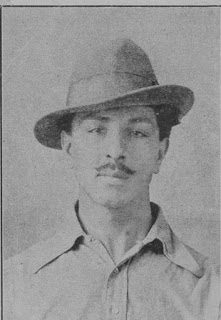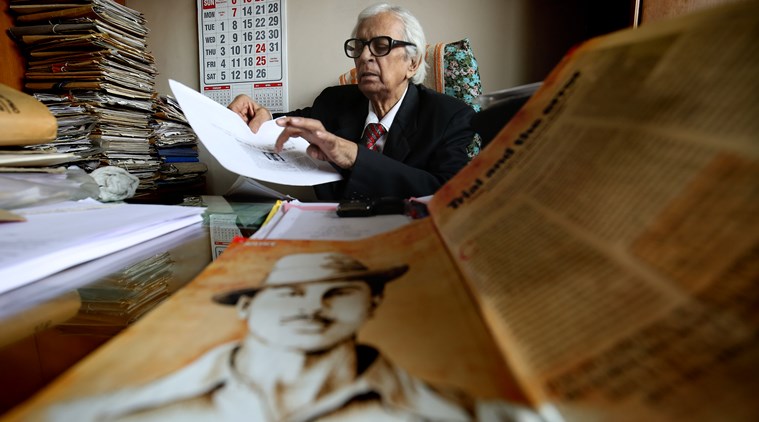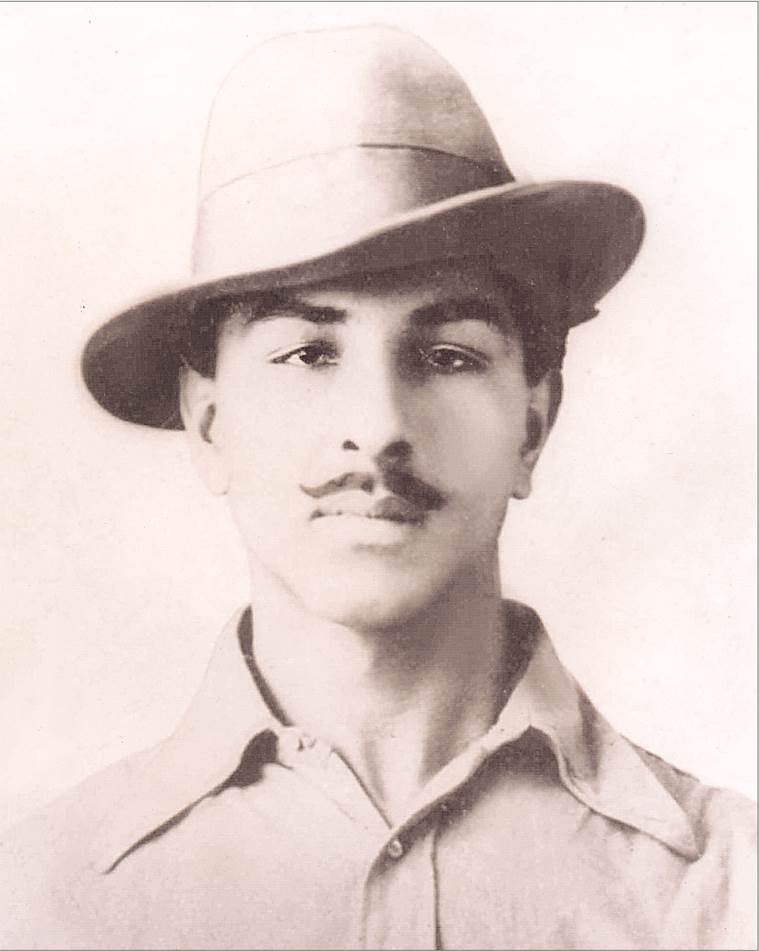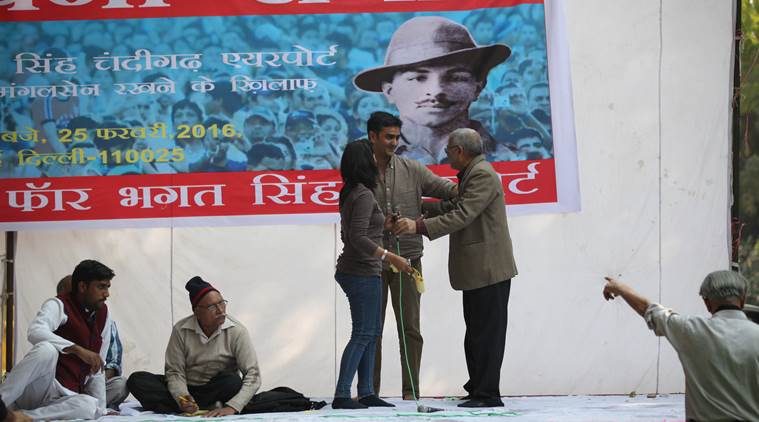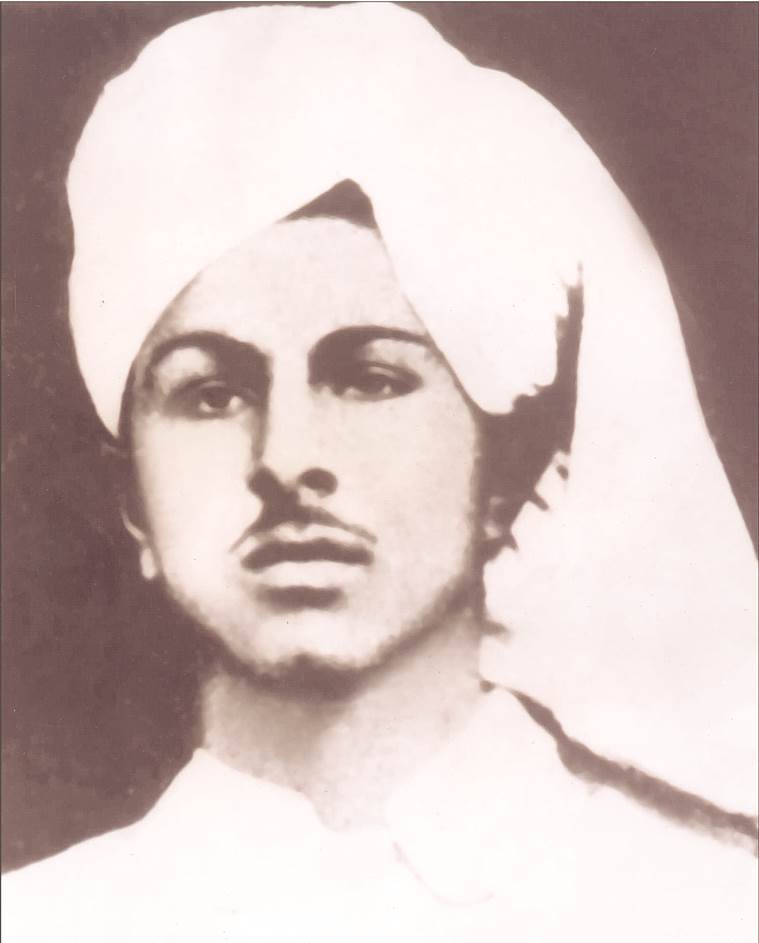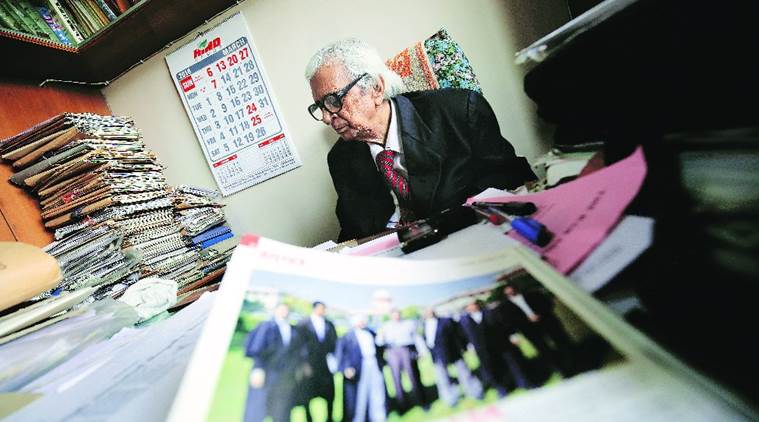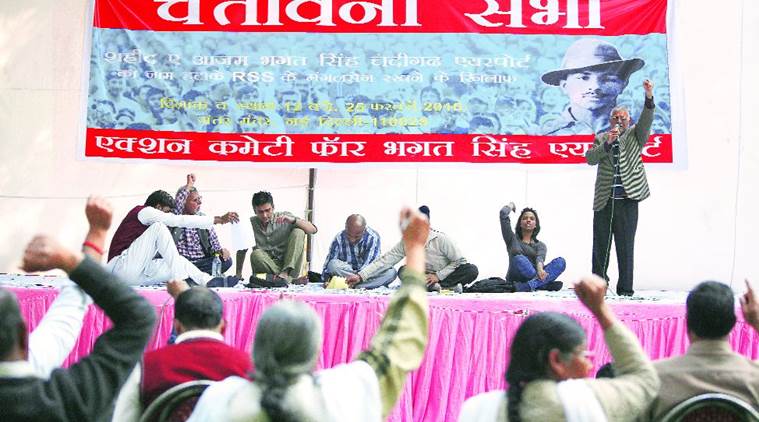I was searching for Dr. Ambedkar's writings on Bhagat Singh, since 2006, when I suddenly recovered Periyar's editorial on Bhagat Singh in 29th March 1931 issue of his Tamil weekly-'Kudai Arsu', while visiting Periyar Tiddle in Chennai. The editorial was translated into English after 75 years of its first publication in Tamil at my request and was published in October 2006 issue of 'The Rationalist', which has been included in my two books-Jail Notebook and Other writings of Bhagat Singh and Understadnign Bhagat Singh.
On 30th January this year I met Subodh More, grand son of historic 1927 Mahad movement account writer R B More, who informed about 'Janta' editorial of Dr. Ambedkar in 1931. He was kind enough to send me the copy of it, which I requested Anand Teltumbde to translate in English and Subhas Gatade in Hindi. Both have been kind enough to provide me English and Hindi translation of the editorial, which is being shared here in both the languages, thanks to Subodh Moe, Anand Teltumbde and Subhas Gatade.
Three Victims-Dr. Ambedkar editorial on Bhagat Singh
execution
(Janata dated 13 April 1931)
Bhagat Singh, Sukhdev
and Rajguru have been eventually hanged. They were charged for the murders of
an English police officer named Sanders and a Sikh police sepoy named Chaman
Singh. Also there were three or four additional charges such as an attempt of
murdering one police inspector at Banaras, throwing a bomb in the Assembly,
conducting robbery at a house in Maulimiya village and looting its valuables.
Bhagatsingh had already admitted to the charges of throwing bomb in the
Assembly. For this crime, he and Batukeshwar Dutt were already sentenced with
life imprisonment. One of the comrades of Bhagatsingh by name Jaigopal had
confessed that the murder of sanders was executed by them revolutionaries
including Bhagatsingh and others. The government had filed a case against
Bhagatsingh and his comrades based on this confession. None of the three
accused participated in this case, however. A special tribunal comprising three
high court judges was appointed which heard the case and unanimously awarded
them death penalty.
Bhagatsingh’s father had made a mercy petition to the
Emperor and the Viceroy requesting them not to execute the punishment and
convert if required into life imprisonment at Andamans. Many people including
prominent leaders also tried to plead with the government in the matter. The
issue of Bhagatsingh’s death penalty might have arisen in negotiations that
took place between Gandhi and Lord Irwin. Although Lord Irwin had not given any
definitive assurance about saving Bhagatsingh’s life, Gandhi’s speech during
the intervening period created a hope that Irwin would try his best within his
powers to save lives of these three youth. But all these hopes, predictions and
appeals proved futile. They were killed by hanging in the Central Prison,
Lahore on 23 March 1931 at 7 pm. None of them had made any appeal for saving
them. But as it is already published, Bhagatsingh had expressed a desire for
being killed with bullet shots instead of hanging by the neck. But even this
last will of his was not granted and they implemented the judgment of the
tribunal verbatim. The judgement was to hang by the neck till dead. If they
were killed with bullet shots, the execution would not confirm to the judgement
verbatim. The order of the justice goddess was obeyed in toto and the three
were killed with the method she prescribed.
For whom the Sacrifice?
If the government thinks that people would be impressed by
its display of devotion to and strict obedience of the justice goddess and
therefore they would approve of this killing, it would be its utter naiveté.
None believes that this sacrifice was made with only intention of maintaining
clean and sans blemish reputation of the British justice system. Even the
government will not be able to convince itself with such an understanding. Then
how will it convince others with this veil of the justice goddess? The entire
world, as well as the government does, knows that it is not the devotion to
justice goddess but the fear of the conservative party and public opinion back
home in England that this sacrifice was executed. They thought, the
unconditional release of political prisoners like Gandhi and signing pacts with
Gandhi’s party has damaged the prestige of the Empire. Some orthodox leaders of
the conservative party have launched a campaign that the prevailing cabinet of
the Labour Party and the Viceroy who danced to its tune were responsible for
it. In such a situation if Lord Irwin had showed mercy to political
revolutionaries who have been convicted for assassinating an English officer,
it would be like giving a burning torch into the hands of the opposition
leaders. Already the condition of the Labour Party is not stable. In such a
situation if these conservative leaders got an alibi that the labour government
grants clemency to the convicts, who had murdered an Englishman, it would be so
easy to provoke public opinion against it. In order to avert this imminent
crisis and to thwart the fire in the minds of conservative leaders from flaring
further, these hangings were executed.
As such this was not to satisfy the justice goddess but to
please public opinion in England. If it had been the issue of personal liking
or disliking of Lord Irwin, he would have within his own powers annulled the
death penalty and awarded life imprisonment in its stead. The cabinet of the
Labour Party in England would have supported Lord Irwin in this decision. It
would have been necessary to maintain congeniality of public opinion in the
context of Gandhi-Irwin pact. While leaving the country, Lord Irwin would
surely have liked to earn this goodwill. But he would have been crushed between
the ire of his conservative kin in England and the Indian bureaucracy imbued
with the same casteist attitude. Therefore, not minding the public opinion here
the government of Lord Irwin hanged Bhagatsingh and his comrades to death and
that too just 2 to 4 days before the Karachi conference of the Congress. Both,
the hanging of Bhagatsingh and his comrades, and its timings, were sufficient
to puncture the Gandhi-Irwin Pact and to trash the efforts to bring it about.
If Lord Irwin wanted to fail this pact, he would not have found better act than
this one. Looking from this perspective, as Gandhiji also felt, one could say
that the government committed a great blunder.
In sum, merely not to incur anger of the conservatives in
England, they sacrificed Bhagatsingh and his comrades ignoring public opinion
and not minding what would happen to the Gandhi-Irwin pact. The government must
remember, howsoever it tries to cover it up or polish it; it will never be able
to hide this fact.
Dr Anand Teltumbde is a writer, political analyst and an
activist with CPDR, Mumbai
भगतसिंह, सुखदेव और राजगुरू की शहादत पर डा अम्बेडकर
/जनता, 13 अप्रैल 1931/
तीन शिकार
भगतसिंह, सुखदेव और राजगुरू इन तीनों को अन्ततः फांसी पर
लटका दिया गया। इन तीनों पर यह आरोप लगाया गया कि उन्होंने सान्डर्स नामक अंग्रेजी
अफसर और चमनसिंह नामक सिख पुलिस अधिकारी की लाहौर में हत्या की। इसके अलावा बनारस में
किसी पुलिस अधिकारी की हत्या का आरोप, असेम्ब्ली में बम फेंकने का आरोप और मौलमिया नामक गांव में एक मकान पर डकैती डाल
कर वहां लूटपाट एवं मकानमालिक की हत्या करने जैसे तीन चार आरोप भी उन पर लगे। इनमें
से असेम्ब्ली में बम फेंकने का आरोप भगतसिंह ने खुद कबूल किया था और इसके लिए उसे और
बटुकेश्वर दत्त नामक उनके एक सहायक दोस्त को उमर कैद के तौर पर काला पानी की सज़ा सुनायी
गयी। सांडर्स की हत्या भगतसिंह जैसे क्रांतिकारियों ने की ऐसी स्वीकारोक्ति जयगोपाल
नामक भगतसिंह के दूसरे सहयोगी ने भी की थी और उसी बुनियाद पर सरकार ने भगतसिंह के खिलाफ
मुकदमा कायम किया था। इस मुकदमें में तीनों ने भाग नहीं लिया था। हाईकोर्ट के तीन न्यायाधीशों
के स्पेशल ट्रीब्युनल का गठन करके उनके सामने
यह मुकदमा चला और उन तीनों ने इन्हें दोषी घोषित किया और उन्हें फांसी की सज़ा सुना
दी। इस सज़ा पर अमल न हो और फांसी के बजाय उन्हें अधिक से अधिक काला पानी की सज़ा सुनायी
जाए ऐसी गुजारिश के साथ भगतसिंह के पिता ने राजा और वायसराय के यहां दरखास्त भी की।
अनेक बड़े बड़े नेताओं ने और तमाम अन्य लोगों ने भगतसिंह को इस तरह सज़ा न दी जाए इसे
लेकर सरकार से अपील भी की। गांधीजी और लॉर्ड इरविन के बीच चली आपसी चर्चाओं में भी
भगतसिंह की फांसी की सज़ा का मसला अवश्य उठा होगा और लार्ड इरविन ने भले ही मैं भगतसिंह
की जान बचाउंगा ऐसा ठोस वायदा गांधीजी से न किया हो, मगर लार्ड इरविन इस सन्दर्भ में पूरी कोशिश करेंगे और अपने अधिकारों
के दायरे में इन तीनों की जान बचाएंगे ऐसी उम्मीद गांधीजी के भाषण से पैदा हुई थी।
मगर यह सभी उम्मीदें, अनुमान और गुजारिशें
गलत साबित हुई और बीते 23 मार्च को शाम 7 बजे इन तीनांे को लाहौर सेन्ट्रल जेल में फांसी दी गयी। ‘ हमारी जान बकश दें’ ऐसी
दया की अपील इन तीनों में से किसी ने भी नहीं की थी; हां, फांसी की सूली पर
चढ़ाने के बजाए हमें गोलियों से उड़ा दिया जाए ऐसी इच्छा भगतसिंह ने प्रगट की थी,
ऐसी ख़बरें अवश्य आयी हैं। मगर उनकी इस आखरी इच्छा
का भी सम्मान नहीं किया गया। न्यायाधीश के आदेश पर हुबहू अमल किया गया ! ‘अंतिम सांस
तक फांसी पर लटका दें’ यही निर्णय जज ने सुनाया था। अगर गोलियों से उड़ा दिया जाता तो
इस निर्णय पर शाब्दिक अमल नहीं माना जाता। न्यायदेवता के निर्णय पर बिल्कुल शाब्दिक
अर्थों में हुबहू अमल किया गया और उसके कथनानुसार ही इन तीनों को शिकार बनाया गया।
यह बलिदान किसके लिए
अगर सरकार को यह उम्मीद हो
कि इस घटना से ‘अंग्रेजी सरकार बिल्कुल न्यायप्रिय है - न्यायपालिका के आदेश पर हुबहू
अमल करती है’ ऐसी समझदारी लोगों के बीच मजबूत होगी और सरकार की इसी ‘न्यायप्रियता’
के चलते लोग उसका समर्थन करेंगे तो यह सरकार की नादानी समझी जा सकती है। क्योंकि यह
बलिदान ब्रिटिश न्यायदेवता की शोहरत को अधिक धवल और पारदर्शी बनाने के इरादे से किया
गया है, इस बात पर किसी का भी यकीन
नहीं है। खुद सरकार भी इसी समझदारी के आधार पर अपने आप को सन्तुष्ट नहीं कर सकती है।
फिर बाकियों को भी इसी न्यायप्रियता के आवरण
में वह किस तरह सन्तुष्ट कर सकती है ? न्यायदेवता की भक्ति के तौर पर नहीं बल्कि विलायत के कान्जर्वेटिव /राजनीतिक रूढिवादी/
पार्टी और जनमत के डर से इस बलिदान को अंजाम दिया गया है, इस बात को सरकार के साथ साथ तमाम दुनिया भी जानती है। गांधी
जैसे राजनीतिक बन्दियों को बिनाशर्त रिहा करने और गांधी खेमे से समझौता करने से ब्रिटिश
साम्राज्य की बदनामी हुई है और जिसके लिए लेबर पार्टी की मौजूदा सरकार और उनके इशारे
पर चलनेवाला वायसरॉय है, ऐसा शोरगुल विलायत
के राजनीतिक रूढिवादी पार्टी के कुछ कटटरपंथी
नेताओं ने चला रखा है। और ऐसे समय में एक अंग्रेज व्यक्ति और अधिकारी की हत्या करने
का आरोप जिस पर लगा हो और वह साबित भी हो चुका हो, ऐसे राजनीतिक क्रांतिकारी अपराधी को अगर इरविन ने मुआफी दी होती
तो इन राजनीतिक रूढिवादियों के हाथों बना बनाया मुददा मिल जाता। पहले से ही ब्रिेटेन
में लेबर पार्टी की सरकार डांवाडोल चल रही है और उसी परिस्थिति में अगर यह मसला राजनीतिक
रूढिवादियों को मिलता कि वह अंग्रेज व्यक्ति और अधिकारी के हिन्दुस्थानी हत्यारे को
भी माफ करती है तो यह अच्छा बहाना वहां के राजनीतिक रूढिवादियों को मिलता और इंग्लैण्ड
का लोकमत लेबर पार्टी के खिलाफ बनाने में उन्हें सहूलियत प्रदान होती। इस संकट से बचने
के लिए और रूढिवादियों के गुस्से की आग न भड़के इसलिए फांसी की इन सज़ा को अंजाम दिया
गया है। यह कदम ब्रिटिश न्यायपालिका को खुश करने के लिए नहीं बल्कि ब्रिटिश लोकमत को
खुश करने के लिए उठाया गया है। अगर निजी तौर पर यह मामला लार्ड इरविन की पसंदगी -नापसंदगी
से जुड़ा होता तो उन्होंने अपने अधिकारों का इस्तेमाल करके फांसी की सज़ा रदद करके उसके
स्थान पर उमर कैद की सज़ा भगत सिंह आदि को सुनायी होती। विलायत की लेबर पार्टी के मंत्रिमंडल
ने भी लार्ड इरविन को इसके लिए समर्थन प्रदान किया होता, गांधी इरविन करार के बहाने से इसे अंजाम देकर भारत के जनमत को
राजी करना जरूरी था। जाते जाते लार्ड इरविन भी जनता का दिल जीत लेते। मगर इंग्लेण्ड
की अपने रूढिवादी बिरादरों और यहां के उसी मनोव्रत्ती की नौकरशाही के गुस्से का वह
शिकार होते। इसलिए जनमत की पर्वा किए बगैर लार्ड इरविन की सरकार ने भगतसिंह आदि को
फांसी पर चढ़ा दिया और वह भी कराची कांग्रेस के तीन चार दिन पहले। गांधी-इरविन करार
को मटियामेट करने व समझौते की गांधी की कोशिशों को विफल करने के लिए भगतसिंह को फांसी
और फांसी के लिए मुकरर किया समय , यह दोनों बातें काफी
थी। अगर इस समझौते को समाप्त करने का ही इरादा लार्ड इरविन सरकार का था तो इस कार्रवाई
के अलावा और कोई मजबूत मसला उसे ढंूढने से भी नहीं मिलता। इस नज़रिये से भी देखें तो
गांधीजी के कथनानुसार सरकार ने यह बड़ी भूल /ब्लंडर/ की है, यह कहना अनुचित नहीं होगा। लुब्बेलुआब यही कि जनमत की परवाह
किए बगैर, गांधी-इरविन समझौते का क्या
होगा इसकी चिन्ता किए बिना विलायत के रूढिवादियों के गुस्से का शिकार होने से अपने
आप को बचाने के लिए, भगतसिंह आदि को बली
चढ़ाया गया यह बात अब छिप नहीं सकेगी यह बात सरकार को पक्के तौर पर मान लेनी चाहिए।
..
/प्रस्तुत अंश ‘डा बाबासाहेब
अम्बेडकर, एम ए, पीएचडी, डीएससी, बार-एट-लॉ’ की अगुआई
में निकलनेवाले पाक्षिक अख़बार ‘जनता’ ज्ीम च्मवचसम’ से लिया गया है। मालूम हो कि जनता
पाक्षिक का पहला अंक 24 नवम्बर 1930 को प्रकाशित हुआ था। लगातार बाईस अंकों के प्रकाशन
के बाद 23 वां और 24 वां अंक ‘संयुक्तांक’ के तौर पर प्रकाशित हुआ।
बाद में ‘जनता’ को साप्ताहिक मंे रूपांतरित किया गया। ‘मूकनायक,’ ‘बहिष्क्रत भारत’, ‘समता’ ऐसी यात्रा पूरी करके अम्बेडकरी अख़बारी आन्दोलन ‘जनता’
तक पहुंची थी।/
(मराठी से हिंदी अनुवाद : सुभाष
गाताडे )


